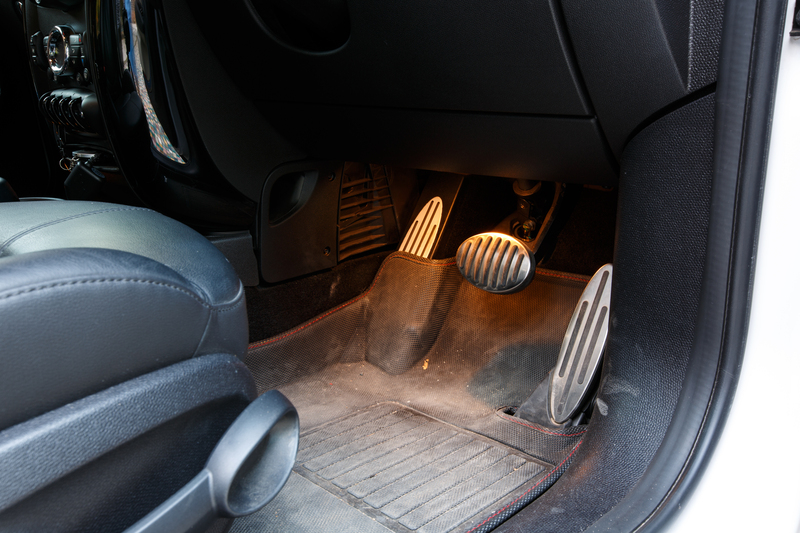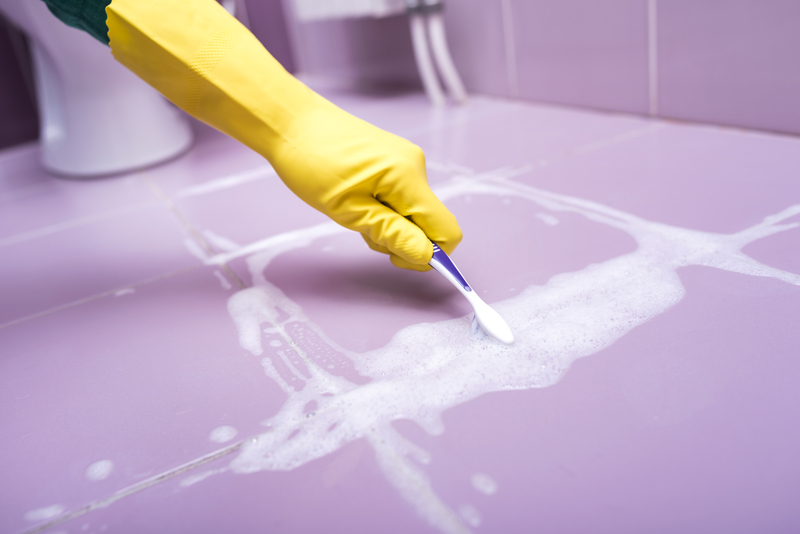Unveiling the Secret to Clean a Stovetop With Burnt-on Mess
Posted on 19/06/2025
Unveiling the Secret to Clean a Stovetop With Burnt-on Mess
A stovetop is the heart of every kitchen, but it can easily become a battleground for spills, splatters, and stubborn burnt-on messes. If you've ever struggled to clean a stovetop with burnt-on mess, you know the frustration of scrubbing for hours and still facing stuck-on residue. Fear not! With the right approach, tools, and techniques, you can restore your stovetop to a gleaming, like-new condition. In this comprehensive guide, we will unveil the secrets to effectively clean burnt-on stove messes, leave your surfaces spotless, and help maintain your cooktop's longevity.

Why Burnt-on Messes Are So Tough
Before jumping into the stovetop cleaning solutions, it's vital to understand why burnt-on food and spills cling so stubbornly. When food, oil, or sauces hit a hot burner, they instantly start to bake into the surface due to the intense heat. With every use, these residues continue to char, forming a rock-hard, sticky layer that's difficult to remove with regular wipes. Cleaning a stove with burnt-on mess thus requires special techniques, patience, and sometimes a little elbow grease.
Preparation: What You'll Need to Tackle Burnt-on Stove Messes
The right cleaning arsenal makes the process much easier. Here are some essential items you'll need to clean burnt-on stovetop stains:
- Baking soda - for gentle, abrasive cleaning
- White vinegar - a natural degreaser and deodorizer
- Dish soap - cuts through grease and grime
- Razor blade or scraper tool - carefully lifts off baked-on residue (check your cooktop manual first to ensure it's safe)
- Soft sponge or microfiber cloths
- Plastic scouring pad
- Old toothbrush - for tricky nooks around burner knobs and edges
- Rubber gloves (optional) - protects hands from harsh cleaners
- Bowl or spray bottle for mixing solutions
Important Safety Note
Never attempt to clean a stovetop while it is hot. Always allow your stovetop to cool completely before starting the cleaning process to avoid burns or injuries.
Step-By-Step: How to Clean a Stovetop With Burnt-on Mess
Ready to get your stovetop sparkling again? Follow these detailed steps for an effective, thorough clean--no matter the severity of the mess.
1. Remove Burner Grates, Knobs, and Drip Pans
- Start by removing all removable parts from your stovetop. This includes grates (for gas stoves), burner caps, control knobs, and any drip trays or pans.
- Soak these parts in a sink filled with warm water and a squirt of dish soap. Let them soak while you tackle the surface mess.
2. Initial Surface Wipe-Down
- Use a damp cloth or sponge to wipe away loose crumbs, dust, and light spills from the stove surface. This helps you focus on the stubborn, burnt-on mess in the next steps.
3. Soften the Burnt-on Stains With Baking Soda Paste
- Mix a paste of baking soda and water (about 3 parts baking soda to 1 part water). Spread this paste generously over the burnt-on spots.
- Baking soda acts as a gentle abrasive and lifts stuck-on residue without scratching most stovetop surfaces. For glass or ceramic cooktops, always avoid harsh abrasive pads.
- Allow the paste to sit for at least 15-30 minutes. The longer the paste sits, the more it breaks down stubborn residue.
4. Attack the Burnt-on Mess
- Use a soft sponge or non-scratch scouring pad to scrub the baking soda paste into the burnt areas.
-
For especially tough spots, carefully use a scraper or razor blade at a shallow angle to lift away the charred particles.
Pro Tip: Always check your appliance manual to ensure that scraping tools are allowed on your stovetop type to avoid damage.
5. Vinegar Spray for Extra Cleaning Power
- Fill a spray bottle with equal parts white vinegar and water. Spritz the stovetop thoroughly, focusing on heavily soiled areas.
- Vinegar dissolves any lingering mineral deposits and acts as a powerful degreaser. Allow it to fizz and sit for a few minutes, then wipe clean with a damp cloth.
6. Deal with Stubborn, Persistent Burnt-on Mess
- For extremely stubborn stains, repeat the baking soda and vinegar method. Alternatively, make a stronger paste by combining baking soda, a splash of lemon juice, and a touch of hydrogen peroxide. Apply, let sit, then scrub gently.
- For grates and drip pans, you may need to use a metal scouring pad or soak them overnight, then scrub with dish soap.
7. Rinse and Polish
- After removing all residue and cleaning solutions, wipe down the entire stovetop with a clean, damp microfiber cloth.
- Buff the surface dry with another soft cloth for a streak-free shine.
- Don't forget to thoroughly dry and replace all the grates, knobs, and pans you removed earlier.
Secret Tips for Cleaning Burnt-on Stove Mess
- Tackle spills as soon as possible - The longer they sit, the harder they are to remove. Wipe up fresh spills right after the stove cools.
- Steam clean using a damp towel - Place a hot, damp towel over stubborn residue for 10-15 minutes to loosen grime before scrubbing.
- Special care for glass/ceramic tops - Use only approved ceramic cleaners and soft sponges to avoid scratching the delicate surface.
- Don't forget the edges and gaps - Use a toothbrush or cotton swab to reach crumbs and stains in tight corners.
- For burners and electric coils - Wipe with a damp cloth; never submerge electric components in water!
Best Homemade Cleaners For Burnt Stovetop Mess
1. Baking Soda and Vinegar Solution
This classic remedy is gentle yet effective for cleaning a stovetop with burnt-on mess. Simply sprinkle baking soda over the stain, spray white vinegar, and let the fizzing reaction help lift burnt residue.
2. Lemon Juice and Hydrogen Peroxide Paste
The acidity in lemon juice and the oxidizing power of hydrogen peroxide breaks down stubborn, deeply baked messes. Mix equal parts lemon juice and hydrogen peroxide with a little baking soda for a spreadable paste: apply, set, and scrub.
3. Dish Soap & Hot Water Soak
For removable parts, soaking in hot, soapy water is sometimes all you need to dislodge burnt-on gunk. Use a stiff brush or pad for any remaining stubborn spots.
4. Commercial Stove Cleaners
If homemade solutions aren't cutting it, use a commercial cooktop cleaner specifically designed for your stovetop material (gas, electric, glass, or ceramic). Always follow manufacturer directions to avoid damage.
How to Clean Different Types of Burnt-On Messes
1. Glass and Ceramic Cooktops
- Only use non-scratch pads or sponges.
- Never use steel wool or abrasive powders, which can permanently scratch or dull the surface.
- Use a razor scraper tool at a shallow angle to gently remove crusty cooked-on spots.
2. Gas Stove Grates and Burners
- Remove, soak, and scrub with a brush or scouring pad.
- For heavy buildup, create a paste of 1 part water, 1 part vinegar, 2 parts baking soda and let soak overnight.
- Rinse thoroughly and dry completely before replacing.
3. Electric Coil Cooktops
- Carefully unplug coils before cleaning.
- Wipe with a damp (not wet) cloth and a bit of dish soap.
- For drip pans, remove and clean as you would gas grates.
Preventing Burnt-on Messes in the Future
Prevention is always easier than cure! Here's how to keep your stovetop clean and avoid stubborn burnt-on messes:
- Wipe down the stovetop after every cooking session. Prompt attention keeps minor spills from becoming burnt-on challenges.
- Use splatter screens and lids when frying or boiling to minimize mess.
- Deep clean removable parts regularly (weekly or bi-weekly).
- Line drip pans with foil (if manufacturer allows).
- Stay near your stove while cooking to catch overflows quickly.

Frequently Asked Questions (FAQ)
Can I use oven cleaner on my stovetop?
Oven cleaner should never be used on glass or ceramic stovetops as it can etch and corrode the surface. For enameled or metal parts, check the manufacturer's instructions before use.
Is it safe to use a razor blade scraper?
Yes, with caution. Always use a blade designed for stovetops and keep it level to avoid scratches. Test in an inconspicuous area first, and avoid this method if your manufacturer advises against it.
How often should I deep clean my stovetop?
Ideally, deep clean every 1-2 weeks, or sooner if you frequently cook oily or messy foods. The more often you clean, the easier each session becomes!
What's best for removing burnt-on sugar spills?
Sugar burns extremely hard and can damage cooktops if not promptly removed. Apply vinegar to soften the sugar, then carefully use a scraper tool for removal. Avoid excessive force to prevent surface scratches.
Conclusion: Your Secret Weapon for a Sparkling Stovetop
With patience, the right supplies, and these expert tips, cleaning a stovetop with burnt-on mess no longer needs to be a dreaded chore. By using household staples like baking soda and vinegar, working methodically, and giving stubborn spots extra attention, you'll restore your stove's shine and extend its life.
Remember, preventative care is the true secret to a perpetually clean stovetop. Wipe spills immediately, deep clean regularly, and use the right tools for your appliance. In no time, your kitchen's centerpiece will be ready for your next culinary adventure--without the hassle of burnt-on stress!
Ready to give your stovetop new life? Roll up your sleeves and let these expert secrets transform your cleaning routine today!




